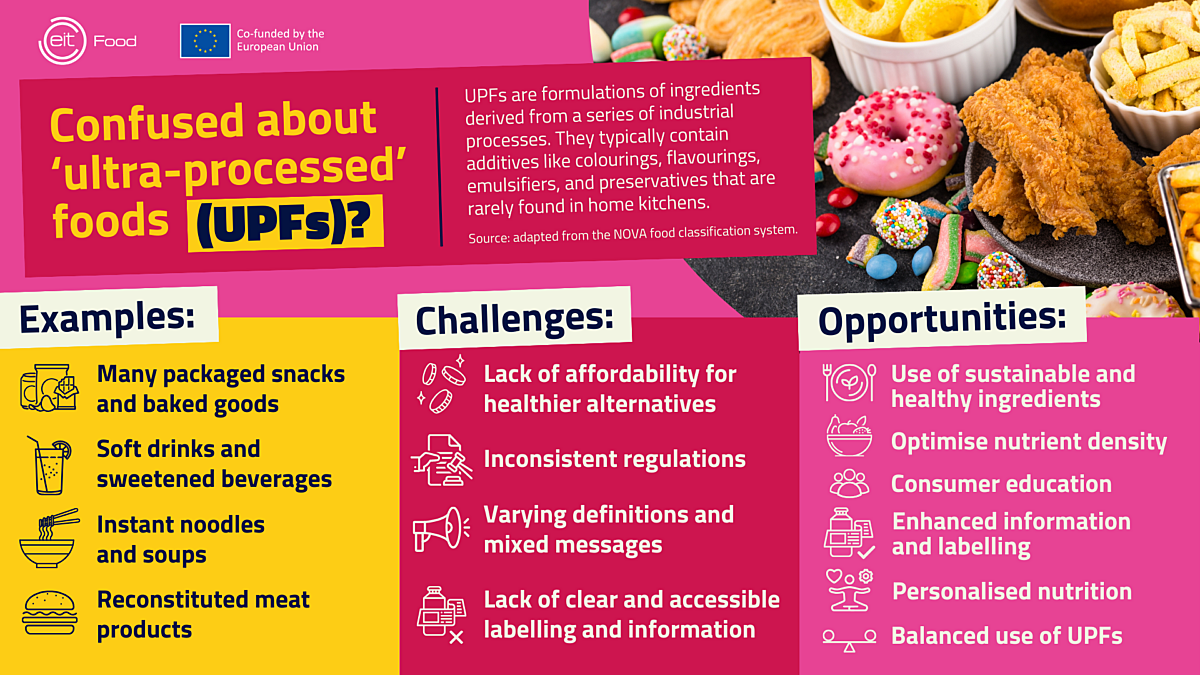
Navigating ultra-processed foods: getting clarity on complexity
Ultra-processed foods (UPFs) have become a contentious topic in nutritional science and public health, igniting debates due to varying definitions, advice, and information. Here we explore the impacts of UPFs, consumer perceptions, regulatory advice, and the solutions fostering clarity and education.
What is ultra-processed food?
The term ‘ultra-processed food’ (UPF) originates from the NOVA classification (1), which categorises foods based on the extent and purpose of their processing. UPFs are formulations of ingredients derived from a series of industrial processes. They typically contain additives like colourings, flavourings, emulsifiers, and preservatives that are rarely found in home kitchens.
Classifying ultra-processed foods
UPFs encompass a wide array of products, including but not limited to (1):
- Packaged snacks and baked goods
- Soft drinks and sweetened beverages
- Instant noodles and soups
- Reconstituted meat products like chicken nuggets
- Pre-prepared frozen meals.
UPFs are foods are engineered to be hyper-palatable, convenient, long-lasting and often low-cost (2), leading to their widespread consumption across Europe and the world. However, there is also widespread confusion when it comes to UPFs.

Confused about ultra-processed foods?
Confusion often arises when discussing or considering ultra-processed foods because the term itself is not uniformly defined or understood across different scientific and regulatory bodies. The NOVA classification was first proposed in 2010 by nutritionist Carlos Augusto Monteiro at the University of São Paulo and colleagues from other Brazilian institutes (3). But its implementation is sometimes described as complex and subjective (4), causing discrepancies in what is deemed ultra-processed. Additionally, marketing strategies and product labelling can obscure the extent of processing, leading to further confusion among consumers.
The majority (65%) of European consumers believe that UPFs are unhealthy but, despite this, continue to choose UPFs; only half (56%) of consumers report that they avoid buying processed foods. Many are also confused and uncertain about the extent to which their food is processed, with consumers both over- and underestimating how processed various food products are (5).
“Giving consumers clearer labelling, guidance and education could help them to better understand and engage with this issue, but it’s also important that concerns over processed food are considered in the wider context of people’s diets and wellbeing. It’s also crucial that we continue to bolster our understanding and agreement of how we classify, evaluate and label foods, so that our advice to consumers is informed by the latest science.”
Understanding the health implications of ultra-processed foods (or not)
While there has previously been uncertainty as to whether the specific processing techniques used to create UPFs are directly responsible for health outcomes such as non-communicable diseases (NDCs) (2), recent studies highlight more concrete findings. One umbrella review published in 2024 of multiple analyses, encompassing almost 10 million participants, found that direct associations do exist between exposure to UPFs and health parameters spanning mortality, cancer, and mental, respiratory, cardiovascular, gastrointestinal, and metabolic health outcomes (7). The study states that the findings provide evidence for developing robust measures to target and reduce dietary exposure to UPFs for improved human health.
However, consumers’ intentions to eat healthily has also been declining for the past few years – with just 56% of consumers reporting that they try and eat healthily, compared to 60% in 2020 and 2021 (8). There are also regional differences to consider, with the intake of industrial trans-fat, for example, being higher in Baltic and Eastern European countries, resulting in a higher prevalence of cardio-vascular diseases (9).

With that being said, returning a profit is a necessary part of any agrifood business, meaning costs must be managed at all stages of production. This can often involve using cheaper alternative ingredients whenever feasible, which can sometimes lead to UPFs with negative health impacts. A notable example is the partial hydrogenation of vegetable oils to convert unsaturated fatty acids into saturated ones, making the oils more solid or "spreadable" (2).
Since the 1920s, this process was used to create solid margarines, which were cheaper and marketed as healthier than butter, and widely utilised in baking, cooking, and frying. However, in the 1990s early warnings indicated that the high trans fatty acid content had severe adverse effects on cardiovascular health, contributing to rising cardiovascular disease mortality rates (2). Consequently, many countries have since restricted or banned trans fats.
Advice, regulation and innovation of ultra-processed foods
Banning UPFs or specific processing techniques is one method for reducing consumption, but regulatory advice on UPFs varies globally. Some countries such as Brazil have adopted the NOVA classification in dietary guidelines, advocating for minimal consumption of UPFs. In contrast, other nations focus on nutrient-specific guidelines, such as reducing added sugars and trans fats, without explicitly addressing processing levels. Many countries refer to processed foods within their guidelines euphemistically such as South Africa advising citizens to “eat more…unrefined ready-to-eat cereals, oats, mealie meal, maltabela, muesli or Nepal suggesting to “eat more wholegrain cereal products and less refined cereals.” (10)
The promotion and funding of healthy, affordable alternatives is another method the industry can take to better support consumers in making healthy food choices.
Within the EIT Food ecosystem, UBLII, for example, makes natural sweet proteins as a healthier, eco-friendly alternative to sugar and sweeteners. Using precision fermentation technology, UBLII provides a sustainable and cost-effective solution to reduce sugar in food and beverage products. Similarly, ReBind Food is working to develop an affordable, plant-based, allergen-free, functional binder from an upcycled food industry byproduct to replace binders commonly used today like sugar, eggs and other food additives.
Solutions that put information front and centre will also support consumers to make more informed decisions. Education courses such as ‘Food and nutrition: The truth behind food headlines’ can help consumers learn how to find reliable, scientific information about food and nutrition. And initiatives that engage and inspire youth such as Food Educators ensure that young people are equipped with the knowledge and resources they need to make informed decisions as they grow up.

Food labelling and packaging solutions that increase the accessibility of nutritional and processing information can also give consumers access to extra knowledge that may support them in their decision making. ScanTrust, for example, allows consumers and industry stakeholders to scan food labels via a QR code which then provides a full overview of the journey of that food product to ensure it is safe, compliant, and authentic.
Personalised nutrition and tailored advice are another route for consumers to take if they are trying to reduce consumption of UPFs and improve their diets. BeYou provides a mobile platform that helps users adopt healthier habits through a combination of gamification, coaching and online community. The startup has designed a goal-setting platform and habit tracker, helping users to choose their health goals, track progress, receive community support, get certified health content, stay committed and get rewarded.
Powder-based food products and formulas are also promising solutions that can support the promotion of healthy diets, thanks to their combination of beneficial ingredients and micronutrients. From microalgae and spent grains to upcycled vegetables and nuts, there are countless innovative powder-based products being developed by startups within the EIT Food community. Read about some of the most innovative from the Affordable Nutrition Scale-Up Challenge here.

Is ultra-processed food all bad?
While the negative health impacts of a diet high in UPFs are well-documented, UPFs are not all inherently harmful. Some fortified or specially designed UPFs such as wholegrain bread can provide essential nutrients and form part of a balanced diet (9). It is essential to recognise that the type and extent of food processing do not necessarily determine the health potential of the final product, and the affordability, long shelf life and convenience of UPFs are often seen as benefits to many people (9).
If you have an idea or solution that can contribute to healthier diets, find out how EIT Food can support you as part of our Impact Funding Framework.
Ultra-processed = ultra-complex
Navigating the world of ultra-processed foods is complex, marked by varying definitions and mixed messages. However, by focusing on clear, transparent information, regulatory consistency, and promoting healthier alternatives, it is possible to mitigate the negative impacts of UPFs. Consumers, empowered with knowledge and supported by robust policies, can make more informed dietary choices, paving the way for better health outcomes.
Learn much more about the deep connections between food and the health of people and planet: sign up to our monthly newsletter The Feed.
References
- ECU Physicians: The NOVA Classification System
- Capozzi F, Magkos F, Fava F, Milani GP, Agostoni C, Astrup A, Saguy IS. A Multidisciplinary Perspective of Ultra-Processed Foods and Associated Food Processing Technologies: A View of the Sustainable Road Ahead. Nutrients. 2021 Nov 5;13(11):3948. doi: 10.3390/nu13113948. PMID: 34836203; PMCID: PMC8619086.
- Carlos Augusto Monteiro et al. A new classification of foods based on the extent and purpose of their processing. Cad. Saúde Pública 26 (11) • Nov 2010 doi: https://doi.org/10.1590/S0102-...;
- Braesco, V., Souchon, I., Sauvant, P. et al. Ultra-processed foods: how functional is the NOVA system?. Eur J Clin Nutr 76, 1245–1253 (2022). https://doi.org/10.1038/s41430-022-01099-1
- EIT Food Consumer Observatory: Ultra-processed foods
- EIT Food: Consumer fear health risks of ultra-processed foods – but lack guidance needed to make healthy choices
- BMJ: Ultra-processed food exposure and adverse health outcomes: umbrella review of epidemiological meta-analyses, 2024;384:e077310
- EIT Food Consumer Observatory: Trust Report 2023
- EIT Food: Healthier Lives Through Food
- The University of Melbourne: Ultra-processed foods: global analysis shows they aren't well sign-posted
More blog posts

Women in food: shaping the future of the industry



